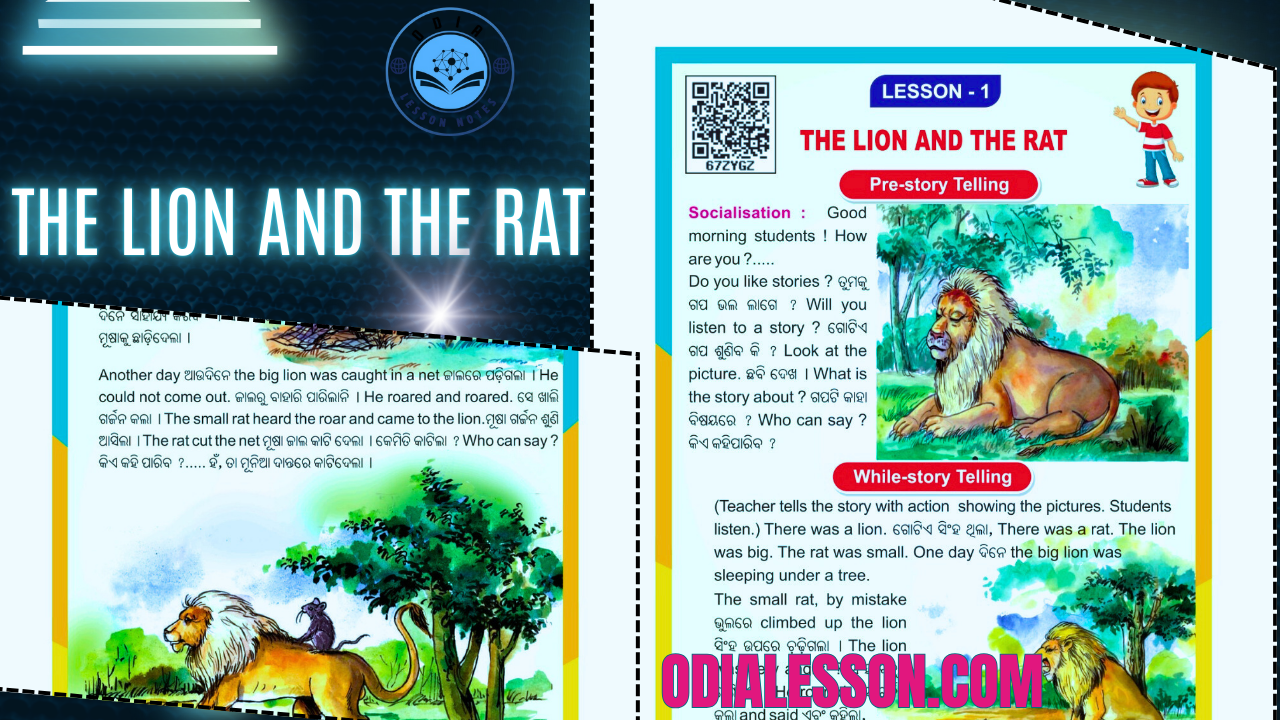Lesson Plan: The Lion and the Rat
Class: 3 Subject: English Topic: The Lion and the Rat (Story)
Book Reference: Pages 7–8
Time Duration: 40–45 minutes Level: Lower Primary Medium of Instruction: Bilingual (English and Odia)
Warm-Up Activities (5–10 minutes)
1. Animal Sounds Game
- Ask: “Can you make the sound of a lion? What about a rat?”
- Let students mimic animal sounds. This builds excitement and sets the scene.
2. Guess the Animals how flashcards or pictures of animals (including lion and rat).
Ask: “Which animal is big?”
“Which one is small?”
“Have you seen them before?”
3. Quick Discussion Ask questions like:
“Have you ever helped someone smaller than you?”
“Do you think a small animal can help a big animal?”
The Lion and The Rat Lesson Plan pdf
The Lion and The Rat Lesson Plan pdf downloadThis comprehensive lesson plan for the story “The Lion and the Rat” is designed for Class 3 English students following the Odisha Board curriculum. It includes clear teaching objectives, engaging classroom activities, moral value discussions, and creative tasks like dra inwing and role-play.
Teachers can use this lesson plan in both standard paragraph format and tabular format for convenience. The story teaches students about kindness, gratitude, and the importance of even the smallest friend. The lesson encourages students to develop listening, speaking, reading, and drawing skills in an interactive way.
Download the PDFs and make your teaching process more effective and enjoyable!
1. General Objectives:
- To develop interest in English through storytelling.
- To enhance the listening, speaking, reading, and writing skills of students.
- To build vocabulary and improve pronunciation.
- To introduce values such as kindness, empathy, and the importance of helping others.
- To promote imagination and creativity through story narration and role play.
2. Specific Learning Outcomes (SLOs):
By the end of the lesson, students should be able to:
- Listen attentively and comprehend the story.
- Retell the story in their own words.
- Read short and simple sentences with correct pronunciation.
- Answer simple questions based on the story.
- Participate actively in class activities like role play and drawing.
- Learn the moral of the story and relate it to real life.
3. Teaching Aids:
- Textbook
- Flashcards (lion, rat, net, roar, help, cut)
- Picture charts/illustrations
- Blackboard and chalk/duster
- Audio/Video clip (QR code in the textbook)
- Story puppets (if available)
- Drawing paper and crayons

5. Previous Knowledge:
Students have already listened to and read short moral stories in earlier classes. They are familiar with basic animals like lion, rat, etc.
6. Introduction (Pre-storytelling stage): (5–7 minutes)
Teacher’s activity:
- Greet the students: “Good morning, students! How are you?”
- Ask questions to set the context:
- Do you like stories?
- Have you ever seen a lion?
- What would you do if you saw a lion and a rat together?
- Show the textbook picture or chart and ask:
- What do you see in the picture?
- What do you think the story is about?
Students’ activity:
- Respond to the teacher’s questions.
- Observe the picture and share their thoughts.
- Show curiosity to listen to the story.
Purpose:
To activate students’ prior knowledge and generate interest in the topic.
7. Presentation (While-storytelling stage): (15–20 minutes)
Story Narration:The teacher tells the story using actions, expressions, and voice modulation, pointing to the pictures in the book.
Story in Simple English:Once there was a big lion. He was sleeping under a tree.A small rat came and climbed on the lion by mistake.The lion woke up. He was very angry.
He said, “I’ll kill you!”The rat said, “Please, don’t kill me. I will help you one day.”The lion laughed and let the rat go.One day, the lion was caught in a net. He roared and roared.The rat heard the roar. He ran to the lion.The rat cut the net with his teeth and saved the lion.The lion said, “Thank you.”Both became good friends.
Vocabulary Explanation:
Roared – ଡାକିଲା, ଗରଜିଲା
Caught – ଧରାପଡ଼ିଲା
Net – ଜାଲ
Cut – କାଟିଦେଲା
Help – ସାହାଯ୍ୟ
Use flashcards and actions to demonstrate meanings.Bilingual support: Explain difficult lines in Odia as needed for clarity.
8. Practice (Post-storytelling stage): (10 minutes)
Comprehension Questions:
Ask oral questions to check understanding:
Who was big in the story?
Who was small?
Why was the lion angry?
What did the rat say?
Who helped the lion?
What is the moral of the story?
Encourage pair discussions or group answers
Reading Practice:Select 4–5 students to read lines from the textbook.Correct pronunciation and intonation gently.
9. Activities: (10 minutes)Activity 1:
Role Play select two students to act as the lion and the rat.Let them enact the main parts of the story using simple dialogues:Lion: “I’ll kill you!”Rat: “Please don’t kill me. I’ll help you one day.”This helps build confidence in speaking and public interaction.
Activity 2: Drawing Ask students to draw the lion and the rat under a tree.Write the title “The Lion and the Rat” on top of the drawing.Encourage coloring and displaying the artwork.
10. Moral Discussion:
Ask the class:
“What do we learn from this story?”
Expected responses:Always be kind.Even small friends can help.Don’t underestimate anyone.Write the moral on the blackboard:“Help can come from anyone, big or small.”Translate it into Odia:
“ସାହାଯ୍ୟ କାହାଠାରୁ ମିଳିପାରେ, ସେ ଛୋଟ କିମ୍ବା ବଡ଼ ହୋଇଥିବା ସତ୍ତ୍ୱେ।”
11.Worksheet

12. Evaluation (Assessment):
Oral Questions:Ask a few students to retell the story in their own words.Reading and Vocabulary Check:Read key words aloud and ask students to read and spell.
Worksheet/Board Work: Match the following.
| A | B |
| Lion | Small |
| Net | Big |
| Roar | Caught |
| Rat | Sound |
| Cut | Teeth |
Answer:Lion – Big, Rat – Small, Roar – Sound, Net – Caught, Cut – Teeth
12. Homework:
- Write 5 new words from the story and use them in sentences.
- Draw and color a picture of the lion and the rat.
- Write 3 sentences about what you learned from the story.
13. Follow-Up Activities:
Assign group storytelling: students can make a similar story with different animals.Create a mini poster with the moral of the story.Encourage students to bring more moral stories to class and narrate.
14. Teacher’s Reflection:
Were the students engaged during the story?Did they understand the key message?Did the activities help reinforce the story?What improvements can be made in the next class?Example:“Most students participated actively and understood the moral well. The drawing activity was highly engaging. Next time, I’ll prepare a puppet show for better involvement.”

